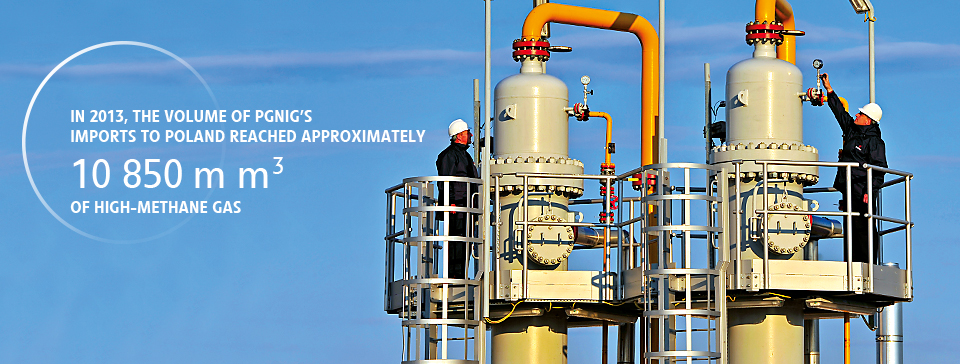2. Corporate governance standards referred to in Section 1 which were not applied by the Issuer, with a statement of reasons for the non-compliance
In 2013, the Issuer did not comply with four of the rules defined in the Code of Best Practice:
- Best practice for supervisory board members – rule 6;
- Best practice for supervisory board members – rule 8;
- Best practice for shareholders – rule 6;
- Best practice for shareholders – rule 10
Grounds for the non-compliance with these rules are presented below.
2.1. Best practice for supervisory board members – rule 6
“At least two members of the supervisory board should meet the criteria of being independent from the company and from entities having material links with the company. With respect to the independence criteria for supervisory board members, Annex II to the Commission Recommendation of February 15th 2005 on the role of non-executive or supervisory directors of listed companies and on the committees of the (supervisory) board should apply. Irrespective of the provisions of point (b) of the said Annex, a person who is an employee of the company or its subsidiary or associate cannot be deemed to meet the independence criteria described in the Annex. Furthermore, an actual and material link with a shareholder having the right to exercise 5% or more of the total vote at the general meeting is deemed to preclude independence of a supervisory board member as defined in this rule.”
In the reporting period, there was only one independent member on the Issuer’s Supervisory Board. Until June 26th 2013 the independent member was Mieczysław Puławski, while from June 26th 2013 to December 30th 2013 it was Zbigniew Skrzypkiewicz, who was delegated by the PGNiG Supervisory Board to temporarily serve as Member of the PGNiG Management Board for Corporate Matters in the period from September 16th 2013 to December 16th 2013. On December 30th 2013, Mr Zbigniew Skrzypkiewicz resigned as Member of the Supervisory Board and on December 31st 2013 was appointed Vice-President of the PGNiG Management Board, Exploration & Production. As at December 31st 2013, no member of the Issuer’s Supervisory Board met the independence criteria.
Pursuant to Par. 36.1 of the Issuer’s Articles of Association (“the Articles of Association”), one of the members of the Supervisory Board appointed by the General Meeting should meet all of the following requirements :
- He or she must be appointed in accordance with the special election procedure set forth in the Articles of Association;
- He or she may not be a related party or a subsidiary of the Issuer;
- He or she may not be a related party of the Issuer’s parent or of another subsidiary of such parent; and
- He or she may not have any connections with the Issuer or with any of the entities referred to in items 2 and 3 which could materially affect his or her ability to make impartial decisions as a member of the Supervisory Board.
Given the fact that, in accordance with Art. 12 of the Act on Commercialisation and Privatisation dated August 30th 1996 (consolidated text in Dz.U. of 2002, No. 171, item 1397, as amended), some of the Company’s Supervisory Board members are elected by employees, the Issuer cannot ensure that the number of independent members on its Supervisory Board is as required by the Code of Best Practice. This would lead to a situation where the State Treasury (the Issuer’s majority shareholder) would be unable to appoint the majority of the Supervisory Board members. This in turn would violate the rule stipulating that a shareholder’s influence on a company’s business should be proportionate to the share capital held by such shareholder.
2.2. Best practice for supervisory board members – rule 8
“With respect to the tasks and the operation of the supervisory board committees, Annex I to Commission Recommendation of February 15th 2005 on the role of non-executive or supervisory directors (...) should be applied”
An Audit Committee operates within the Issuer's Supervisory Board as a standing committee, advising the Supervisory Board on matters within the Committee’s remit.
For a detailed description of the Audit Committee’s rules of operation, see Section 11.3 hereof.
Pursuant to the Code of Best Practice, with respect to the tasks and the operation of its Supervisory Board committees, the Issuer should apply the rules laid down in Annex I to Commission Recommendation of February 15th 2005 on the role of non-executive or supervisory directors of listed companies and on the committees of the (supervisory) board. In the case of the Audit Committee, the primary purpose of the rules is to ensure that the Audit Committee performs its role correctly. The Issuer has complied with all the requirements which guarantee the Audit Committee’s involvement in the supervision of the Issuer’s business. However, the Issuer did not comply with all the detailed requirements for the operation of the Committee. The requirements which the Issuer did not comply with include:
- the rule laid down in Section 4.1 of Annex I, pursuant to which at least a majority of the Audit Committee members should be independent;
- the rule laid down in Section 4.3.2 of Annex I, pursuant to which the management should inform the audit committee of the methods used to account for significant and unusual transactions where the accounting treatment may be open to different approaches;
- the rule laid down in Section 4.3.8 of Annex I, pursuant to which the audit committee should review the process whereby the company complies with the existing regulations regarding the possibility for employees to report alleged significant irregularities in the company, by way of complaints or through anonymous submissions, normally to an independent director, and should ensure that arrangements are in place for the proportionate and independent investigation of such matters and for appropriate follow-up action.
Given the way the Audit Committee currently operates, the Issuer does not consider it necessary to introduce very detailed rules to regulate its operation. The Issuer will take appropriate steps in the future, if justified by the actual manner of operation of the Audit Committee.
2.3. Best practice for shareholders – rule 6
“The dividend record date and the dividend payment date should be set so as to ensure the shortest possible intervening period, in each case not longer than 15 business days. A longer period between these dates requires detailed grounds.”
On May 22nd 2013, at the request of the shareholder State Treasury of Poland, a draft resolution on the distribution of profit for the financial year 2012, allocation of retained earnings, and setting of the dividend record and dividend payment dates was amended. As a result, the Annual General Meeting set July 20th 2013 as the dividend record date and October 3rd 2013 as the dividend payment date. In 2011, however, the Issuer had introduced the “Procedure for accounting for and payment of dividend by PGNiG S.A.” to serve as a future source of best practice in this respect.
2.4. Best practice for shareholders – rule 10
“A company should enable its shareholders to participate in a General Meeting using electronic communication means through:
1) Real-life broadcast of General Meetings,
2) Real-time bilateral communication where shareholders may take the floor during a General Meeting from a location other than the General Meeting.”
The Company has decided not to comply with the rule as the Company’s Articles of Association currently do not provide for shareholders’ participation in a General Meeting using electronic means of communication. In accordance with the Commercial Companies Code, bringing into effect the above corporate governance rule would require a relevant amendment to the Company’s Articles of Association. Upon amendment to its Articles of Association, the Company will be able to comply with the rule in the future.





